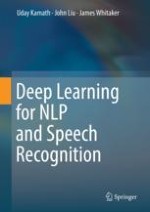2019 | OriginalPaper | Chapter
4. Basics of Deep Learning
Authors : Uday Kamath, John Liu, James Whitaker
Published in: Deep Learning for NLP and Speech Recognition
Publisher: Springer International Publishing
Activate our intelligent search to find suitable subject content or patents.
Select sections of text to find matching patents with Artificial Intelligence. powered by
Select sections of text to find additional relevant content using AI-assisted search. powered by
